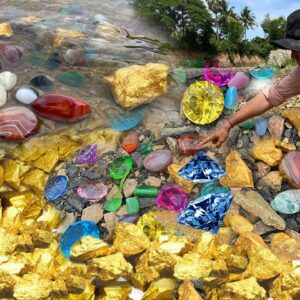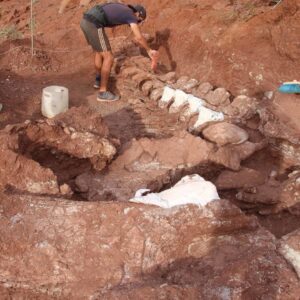
A gold coin of the Roman emperor Sponsian. Image credit: Pearson et al., doi: 10.1371/journal.pone.0274285.
For much of ancient Roman history, Roman mints produced coins featuring portraits of current emperors.
In 1713, an assemblage of such coins was allegedly discovered in Transylvania, Romania, some of them featuring a portrait labeled with the name Sponsian, although there are no other historical records that a Roman emperor named Sponsian ever existed.
When the coins were discovered, they were thought to be genuine and classed alongside other imitations of Roman coins made beyond the fringes of the empire.
However, from the mid-19th century, attitudes changed. The coins from the hoard were dismissed as forgeries because of the way they looked. This has been the accepted view until now.
“Scientific analysis of these ultra-rare coins rescues the emperor Sponsian from obscurity,” said Professor Paul Pearson, a researcher in the Department of Earth Sciences at University College London.
“Our evidence suggests he ruled Roman Dacia, an isolated gold mining outpost, at a time when the empire was beset by civil wars and the borderlands were overrun by plundering invaders.”

Coins from the Transylvania assemblage and their typology. Image credit: Pearson et al., doi: 10.1371/journal.pone.0274285.
To investigate the Transylvanian coins’ authenticity, Professor Pearson and his colleagues from the University of Glasgow conducted a deeper assessment of the physical characteristics of four of the coins, including the Sponsian coin.
The researchers applied visible light microscopy, ultraviolet imaging, scanning electron microscopy, and reflection mode Fourier transform infra-red spectroscopy to the four coins and, for comparison, two undoubtedly authentic Roman gold coins.
The analysis revealed deep micro-abrasion patterns typically associated with coins that were in circulation for an extensive period of time.
The authors also analyzed earthen deposits on the coins, finding evidence that after extensive circulation, the coins were buried for a prolonged period before being found.
Together, the new evidence strongly suggests the Transylvanian coins are authentic.
Considering the historical record alongside the new evidence from the coins, the scientists suggest that Sponsian was an army commander in the Roman Province of Dacia during a period of military strife in the 260s CE.
“The two Dacian legions — XIII Gemina and V Macedonica — had remained loyal to Rome in the civil wars of the late 250s and were awarded the titles pia (dutiful) and fidelis (faithful) on multiple occasions in that period,” they said.
“We suggest that Sponsian may have been the commanding officer (dux) of these legions and the combined forces of Dacia, and that he led a secessionist regime within a time window extending from 260 to the mid-270s at a time when most of the rest of the empire was wracked by civil war and collapsed frontiers, and secure communication with Rome was impossible.”
“His priority would have been to protect the population and resist being over-run by hostile tribes.”
“In this scenario, he was not technically a usurper challenging central authority, but his imperium might be considered a local necessity.”





